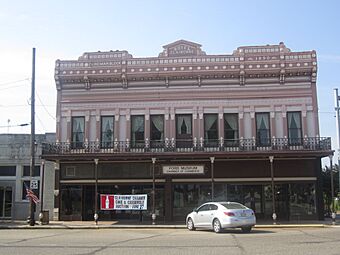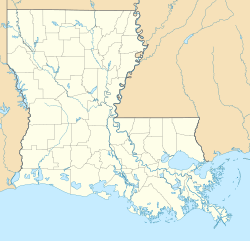Herbert S. Ford Memorial Museum facts for kids
Quick facts for kids |
|
|
Hotel Claiborne
|
|
|
U.S. Historic district
Contributing property |
|

The museum from town square in 2012
|
|
| Location | 519 South Main Street Homer, Louisiana 71040 |
|---|---|
| Built | 1890 |
| Architectural style | Italianate |
| Part of | Homer Historic District (ID86001994) |
| Designated CP | August 28, 1986 |
The Herbert S. Ford Memorial Museum is a cool place to learn about local history and culture. It's located in Homer, Louisiana, inside an old building that used to be the Claiborne Hotel. You can find it at 519 South Main Street. The museum is a two-story building right across from the town square. The Homer Chamber of Commerce also has its office inside the museum.
Contents
About the Museum
The museum building is a special historical site. It's listed on the National Register of Historic Places. The museum opened in 1982. It holds a large collection of items gathered by a local businessman named Herbert Ford. He lived from 1889 to 1960. His collection started way back in 1924. Herbert Ford was a captain in the United States Army during World War I. He and his wife, Ruth Meadows, faced a sad loss when their son died at sea during World War II.
Cotton and Oil History
The museum has a really old bale of cotton. It's said to be the oldest compressed cotton bale in the United States! This cotton was baled around 1930. There's a similar bale at the Louisiana Cotton Museum.
Next to the cotton, you'll see "Black Gold." This is a model of an oilfield worker called a roughneck. Roughnecks were general laborers who helped with drilling equipment. This model shows a roughneck from the early 1930s. He worked for the Sinclair Oil and Gas Company. A recording at the exhibit tells the story of a farm family. They had a hard time growing cotton and corn in Mississippi. So, they moved to Claiborne Parish to find work in the oil and natural gas industry. The recording says, "Oil changed our lives forever. We owe a lot to the men, mud, and mules that made it happen."
Oil was first found in Homer in 1921. Another big oil discovery happened that same year in Haynesville. The oil boom lasted through the 1930s. This brought many visitors to the Hotel Claiborne, which first opened in 1890.
Military Stories
Downstairs, there's a small exhibit about the American Civil War. You can see three Confederate flags on the wall. A very touching part is a letter written to a widow. Her husband was killed in the Battle of Atlanta in Georgia on July 20, 1864. The letter offers comfort and praises her husband as a "true patriot and a good soldier."
Upstairs, there's a section honoring military veterans from the 1900s. Two special people are recognized:
- Larry Sale: He was the Claiborne Parish sheriff from 1936 to 1944. He was also Louisiana's most decorated soldier from World War I.
- David Wade: Born in 1911, he became a lieutenant general and served in three wars. He received more than a dozen medals. The Wade Correctional Center, a state prison, is named after him.
Other Cool Exhibits
The Ford Museum shows an old ballot box. It explains that before the 1890s, people would say their votes out loud. They didn't have secret ballots like we do today. There's also a framed copy of the 1935 centennial edition of the Shreveport Journal newspaper.
You can see a pirogue, which is a type of dugout canoe. It was made from cypress logs. Both Native Americans and early pioneers used these canoes. The museum also has replicas of old irons and ironing boards. There's a water wheel, a bank, a railroad station, and even a judge's office. You can also see a doctor's office, canning supplies, and a general store with old glass milk bottles. There's a gun rack, a carriage, a chapel, and even mounted African mammals.
One exhibit shows an early guest room from the Claiborne Hotel. A log cabin from the George Green homestead is also on display. It has a combined bedroom and dining table. You can see several radios from the 1930s. One is a large Philco cabinet model. People might have listened to President Franklin D. Roosevelt's "fireside chats" on radios like this.
There's a model school classroom. It has information about Forney C. Haley, who was the Claiborne Parish Superintendent from 1945 to 1969. He also led the Louisiana Superintendents Association. The museum also has a poster about Reverend Roy Mayfield. He started the Homer Norman Institute in 1900. The St. John School later became the first four-year high school for Black students in Claiborne Parish.
You might also spot a poster about Pat Garrett. He was a frontier peace officer from Alabama. He grew up near Haynesville before moving to New Mexico. He is famous for shooting the bandit Billy the Kid. Garrett himself was shot and killed in 1908.
The museum also mentions clothing designer Geoffrey Beene. He was from Haynesville. In 1963, he became the first American designer to start his own company. He designed the dress that Lynda Bird Johnson wore for her wedding in 1967.
Old-Time Values
The museum highlights important values from the past. One sign says, "Self-Reliance was the key to survive in frontier times." It explains that many early farmers became skilled blacksmiths. They built outdoor forges and worked outside when the weather was good.
Another sign is at the sewing and quilting exhibit. It says that pioneer women expressed themselves through their quilts. These "Legacy quilts" were passed down from mothers to children. They told stories of family life, like fires, storms, first loves, weddings, births, and lost homes.
Visiting the Museum
It costs $3 for adults to visit the Ford Museum. For children, it's $1. A family can visit for a maximum of $5. The museum is open from 9:30 AM to 12 PM and 1:30 PM to 4 PM on Mondays, Wednesdays, and Fridays. You can also visit by making an appointment.



